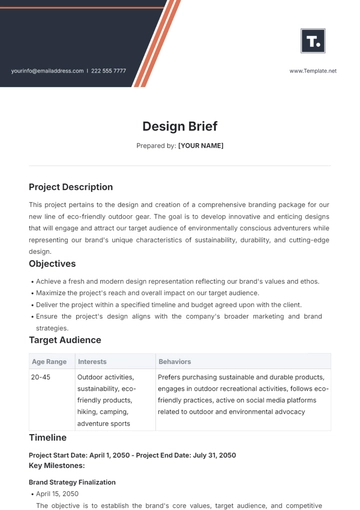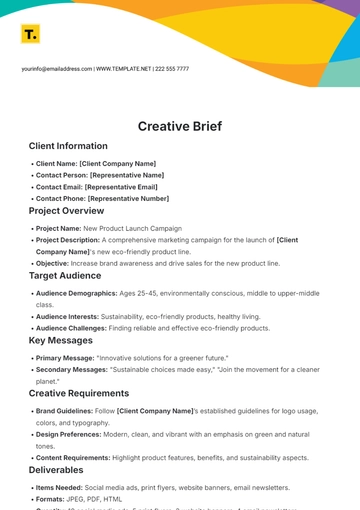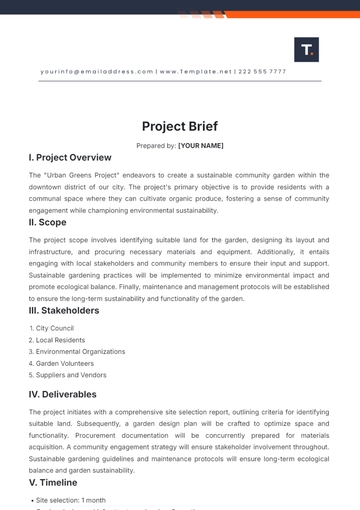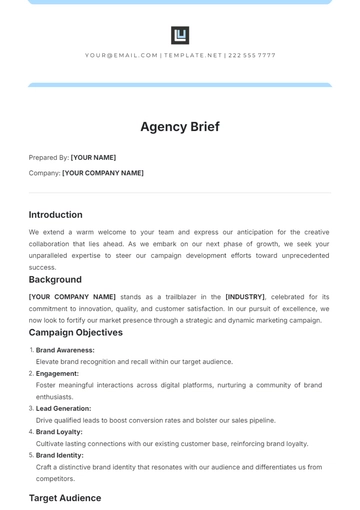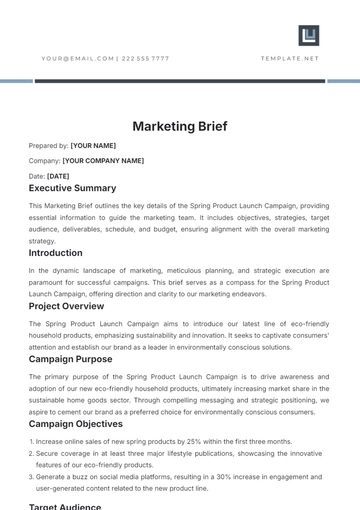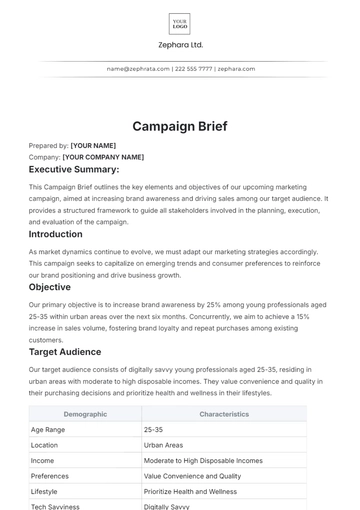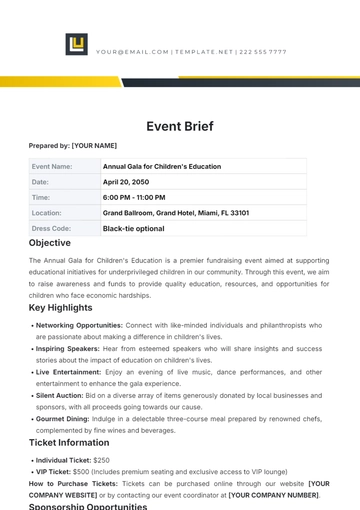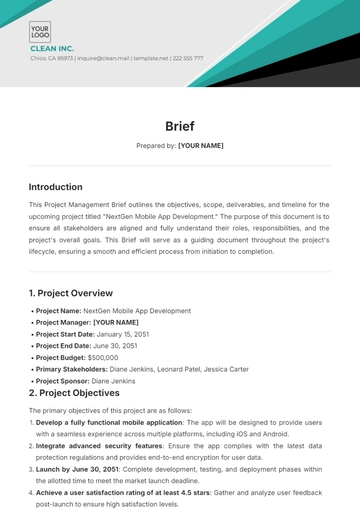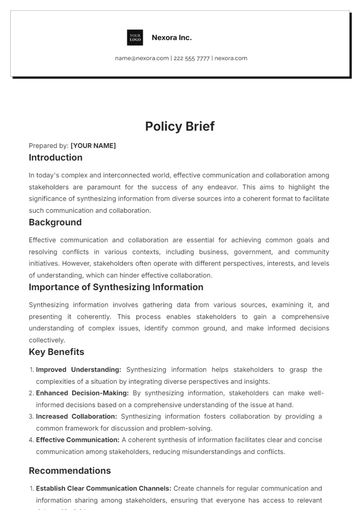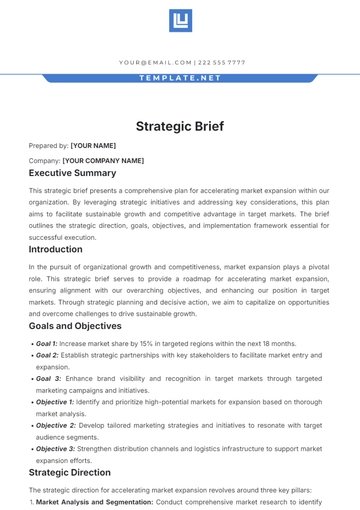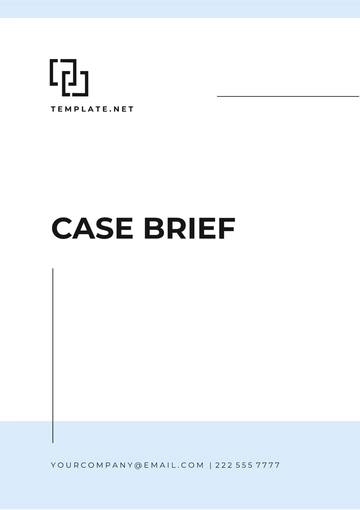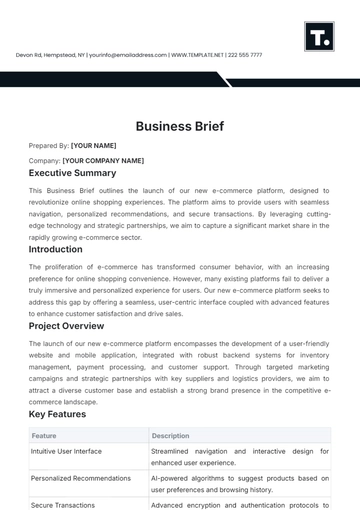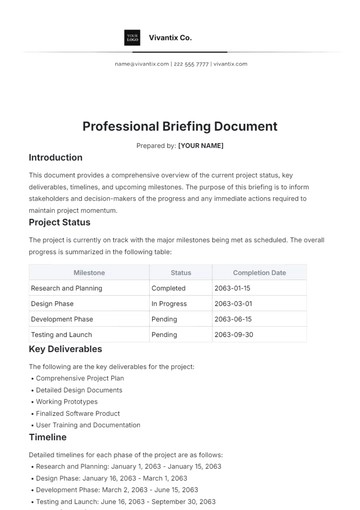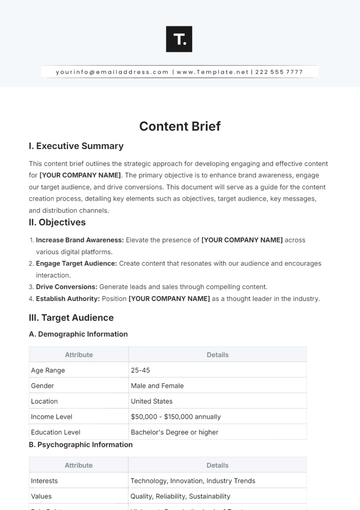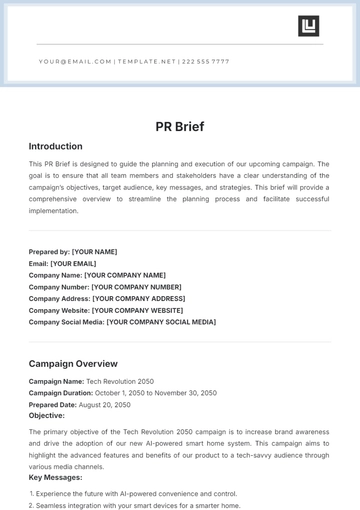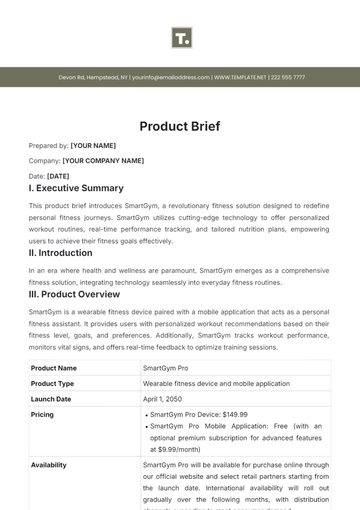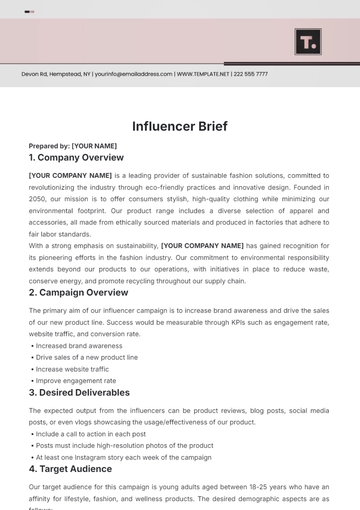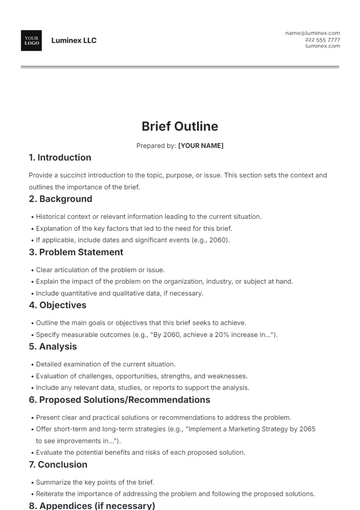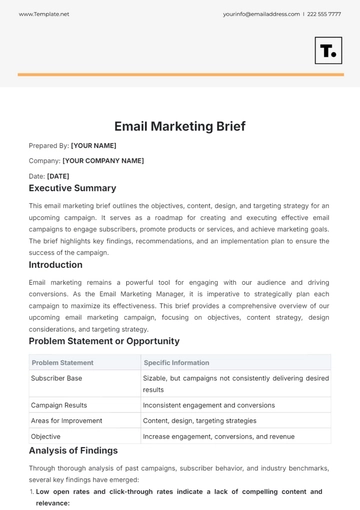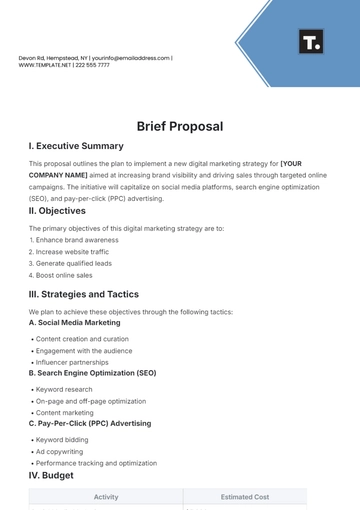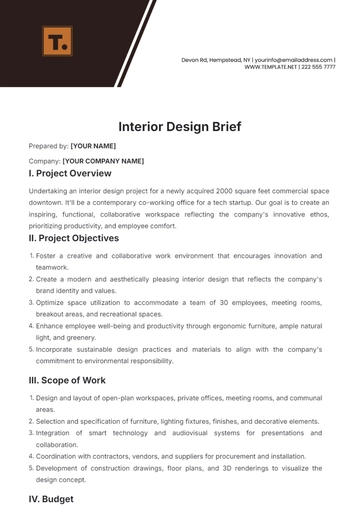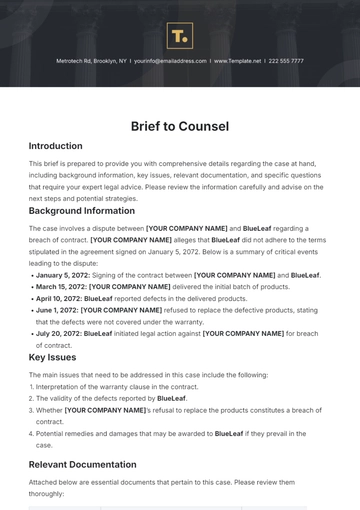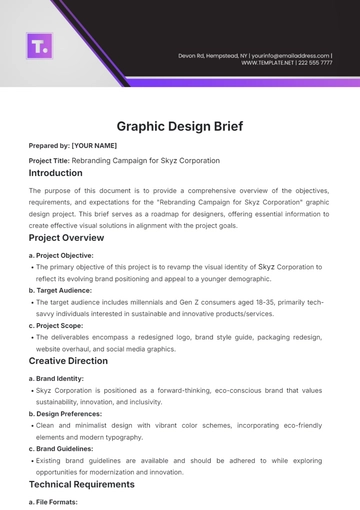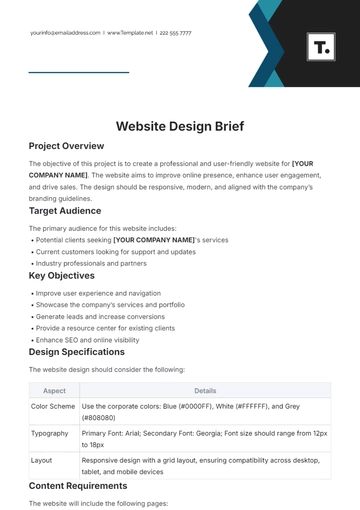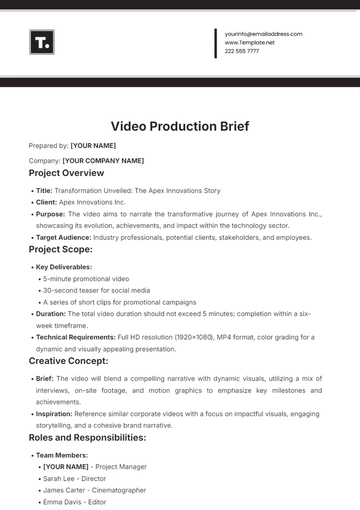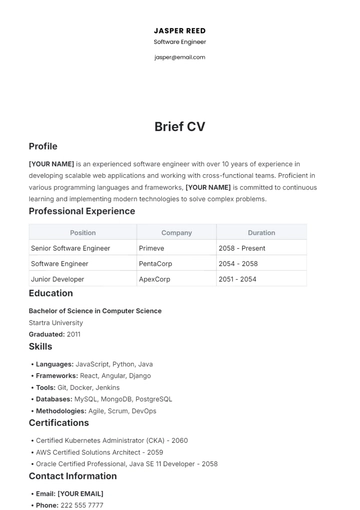Free Architectural Project Brief
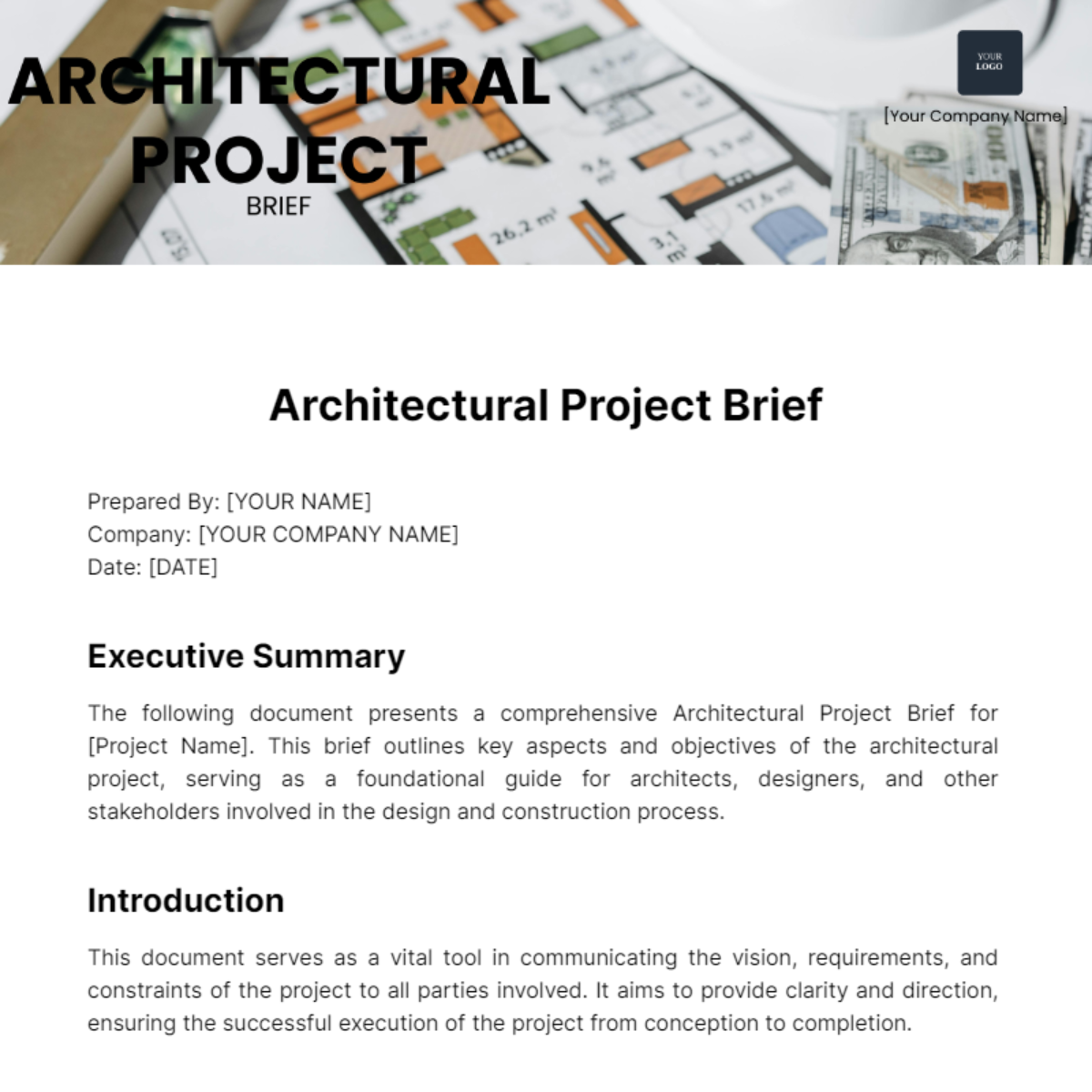
Prepared By: [YOUR NAME]
Company: [YOUR COMPANY NAME]
Date: [DATE]
Executive Summary
The following document presents a comprehensive Architectural Project Brief for [Project Name]. This brief outlines key aspects and objectives of the architectural project, serving as a foundational guide for architects, designers, and other stakeholders involved in the design and construction process.
Introduction
This document serves as a vital tool in communicating the vision, requirements, and constraints of the project to all parties involved. It aims to provide clarity and direction, ensuring the successful execution of the project from conception to completion.
Client Information
[Project Name] is a leading real estate development company known for its commitment to innovation and excellence. As the client for the [Project Name], they bring a wealth of experience and vision to the project. [YOUR NAME], CEO of [YOUR COMPANY NAME], serves as the primary contact for strategic decisions and overarching project goals. [Project Manager's Name], the appointed Project Manager, will liaise closely with the architectural team to ensure seamless communication and successful project delivery
Project Overview
[Project Name] seeks to [briefly describe the purpose and goals of the project]. It will [briefly mention the scale, function, and significance of the project].
Site Information
Project Name | The Oasis Tower Project |
|---|---|
Purpose and Goals | To create a sustainable mixed-use development |
Scale | Large-scale urban development |
Function | Residential, commercial, and recreational spaces |
Significance | Enhancing community life and setting |
Project Objectives
Functionality: Optimize space for efficient use, catering to specific needs and activities.
Aesthetics: Design visually appealing spaces reflecting the client's identity and preferences.
Sustainability: Implement eco-friendly practices to minimize environmental impact and promote well-being.
Accessibility: Ensure inclusive design meets all accessibility standards and regulations.
Adaptability: Create flexible spaces accommodating future changes and evolving needs.
Budget & Timeline: Deliver within budget and adhere to project timeline efficiently.
Stakeholder Satisfaction: Collaborate closely with stakeholders to meet or exceed expectations.
Regulatory Compliance: Ensure full compliance with building codes and legal requirements.
Additional Objectives:
Resilience: Build structures resilient to environmental challenges for safety and longevity.
Innovation: Explore innovative solutions to enhance project quality and performance.
Historical Preservation: Respect and integrate historical elements into the design where applicable.
User Comfort: Prioritize comfort through optimized lighting, ventilation, and acoustics.
Identity Expression: Reflect community or organizational identity in the design.
Scope of Work
The scope of work for the [Project Name] encompasses a comprehensive range of tasks and responsibilities to ensure the successful completion of the project. While not exhaustive, the following provides specific details regarding each aspect:
Architectural Design:
Develop conceptual design proposals in line with client requirements and project objectives.
Prepare schematic designs, design development drawings, and final construction documents.
Coordinate with structural, interior, and landscape designers to integrate design elements seamlessly.
Structural Design:
Engage structural engineers to analyze and design the building's structural framework.
Ensure structural integrity and compliance with relevant building codes and regulations.
Collaborate with architectural and construction teams to implement structural design solutions effectively.
Interior Design:
Create interior design concepts that enhance functionality, aesthetics, and user experience.
Select and specify interior finishes, fixtures, furniture, and equipment.
Coordinate with architects and contractors to ensure alignment between interior and architectural design elements.
Landscape Design:
Design outdoor spaces that complement the architectural vision and site context.
Specify plantings, hardscape elements, lighting, and irrigation systems.
Integrate sustainable landscape practices and environmental considerations into the design.
Construction Documentation:
Prepare detailed construction drawings, specifications, and schedules.
Document all aspects of the project to facilitate the bidding and construction processes.
Ensure accuracy and clarity in all construction documents to minimize errors and discrepancies during construction.
Permitting:
Coordinate with regulatory agencies to obtain necessary permits and approvals.
Ensure compliance with zoning ordinances, building codes, and other regulatory requirements.
Facilitate the permit application process and address any regulatory issues that may arise.
Construction Administration:
Provide on-site supervision and quality control during the construction phase.
Review shop drawings, submittals, and construction progress to ensure adherence to design intent and specifications.
Address any construction-related issues or conflicts that may arise and facilitate timely resolution.
Constraints and Limitations
Regulatory Constraints or Limitations:
Compliance with local building codes, zoning regulations, and other legal requirements enforced by relevant authorities.
Adherence to historic preservation guidelines if applicable to the project site.
Environmental regulations, including requirements for sustainable design, energy efficiency, and waste management.
Site-Specific Constraints or Limitations:
Topographical challenges such as steep slopes, flood zones, or geological hazards may affect construction.
Limited space for construction activities, staging, and material storage.
Existing structures or features on the site must be preserved, integrated, or removed.
Budgetary Constraints:
The total project budget is set at [specific amount], which must encompass all design, construction, and administrative costs.
Any proposed design solutions must align with the allocated budget and prioritize cost-effective materials and methods.
Contingency funds will be reserved for unforeseen expenses or changes during the project lifecycle, within the predefined budget limits.
Additional Constraints or Limitations:
Time constraints: The project must be completed within [specific timeframe], taking into account any seasonal or weather-related limitations.
Stakeholder requirements: Any specific requirements or preferences outlined by the client, end-users, or other stakeholders must be considered within the project scope.
Quality standards: The final design and construction must meet or exceed industry standards for safety, durability, and aesthetics.
Addressing these constraints and limitations will be critical to the success of the project, requiring careful planning, coordination, and collaboration among all stakeholders involved.
Design Criteria
Functionality: Prioritize usability and efficiency to serve intended purposes effectively.
Aesthetics: Create visually appealing spaces with harmonized elements and finishes.
Sustainability: Minimize environmental impact and maximize energy efficiency.
Contextual Sensitivity: Respond sensitively to the surrounding context and cultural heritage.
Flexibility and Adaptability: Design spaces to accommodate future changes and evolving requirements.
Accessibility and Inclusivity: Ensure all individuals can comfortably use the spaces.
Durability and Maintenance: Select durable materials requiring minimal upkeep.
Innovation and Creativity: Encourage innovative solutions to achieve project goals.
Budget and Schedule
Budget: $5,000,000
Phase | Duration |
|---|---|
Design Development | |
| 2 months |
| 3 months |
Permitting | |
| 1 month |
Construction | |
| 1 month |
| 4 months |
| 6 months |
| 6 months |
Post-Construction | |
| 1 month |
| 1 month |
The schedule is subject to change based on permitting approvals, weather conditions, and unforeseen delays. The budget includes allowances for contingencies and unforeseen expenses.
Stakeholder Requirements
Stakeholder requirements encompass a range of considerations vital to the success of [Project Name]. These requirements are as follows:
Client Preferences and Expectations:
The client envisions [specific preferences and expectations, such as architectural style, materials, spatial layout, and aesthetic preferences].
Key elements of the client's vision include [describe any unique or essential features desired by the client].
Regulatory Requirements:
Compliance with local building codes, zoning ordinances, and other regulatory standards is paramount.
The project must adhere to [specific regulations and codes related to zoning, building occupancy, fire safety, and other relevant areas].
Environmental Considerations:
Environmental sustainability is a priority for the project.
Design solutions should aim to minimize environmental impact and promote energy efficiency.
Incorporation of green building practices, such as passive design strategies, use of sustainable materials, and integration of renewable energy sources, is encouraged.
Safety Standards:
The safety of occupants and users is of utmost importance.
Design and construction must comply with industry-standard safety protocols and regulations.
Measures to address fire safety, structural integrity, and emergency egress will be incorporated into the project.
Accessibility Requirements:
The project must be accessible to individuals with disabilities by accessibility standards, such as the Americans with Disabilities Act (ADA) and relevant local regulations.
Design considerations include accessible entrances, pathways, restroom facilities, and other amenities to ensure inclusivity and usability for all users.
Conclusion
The Architectural Project Brief for [Project Name] provides a comprehensive overview of the project's objectives, scope, constraints, and requirements. It serves as a foundational document to guide the design and construction process, ensuring alignment with the client's vision and goals. We look forward to collaborating with all stakeholders to bring this project to fruition successfully.
- 100% Customizable, free editor
- Access 1 Million+ Templates, photo’s & graphics
- Download or share as a template
- Click and replace photos, graphics, text, backgrounds
- Resize, crop, AI write & more
- Access advanced editor
Introducing the Architectural Project Brief Template, exclusively available on Template.net. This editable and customizable template empowers architects to craft comprehensive project outlines effortlessly. Seamlessly integrate your ideas with our Ai Editor Tool, ensuring precision and clarity in every detail. Elevate your architectural projects with a template designed for seamless collaboration and unparalleled project clarity.
